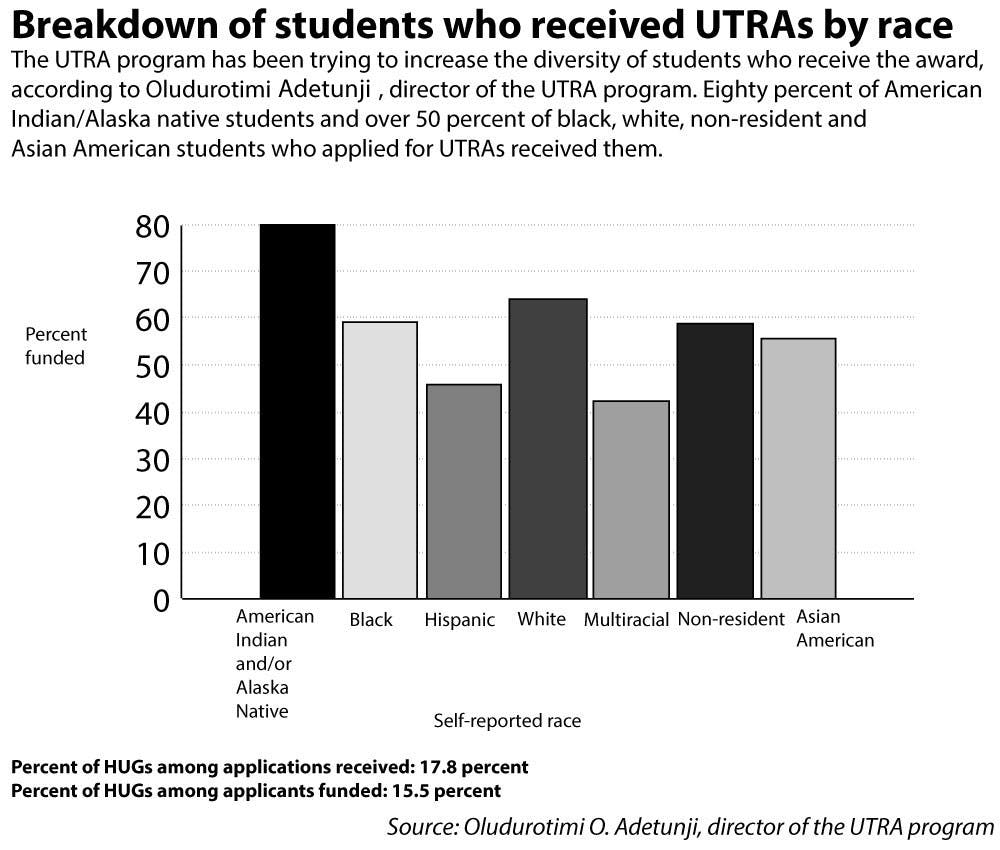Each year, Undergraduate Teaching and Research Awards provide students with funding to conduct research with a University faculty member. The recently announced cohort of recipients for this summer include students across various fields of study who received funding for both standard and Interdisciplinary-Team UTRAs, said Oludurotimi Adetunji, associate dean for undergraduate research and inclusive science and director of the UTRA program.
This summer will be the third year of the University’s recently developed I-Team UTRAs, which fund teams of two to six students to collaborate on projects. The aim of this award is to provide opportunities for a wide range of first- and second-year underrepresented students and those “who haven’t done much research before or are underrepresented,” Adetunji said.
Of the funded UTRAs for this summer, 15.5 percent were awarded to historically underrepresented groups, he said. Applications from HUGs made up 17.8 percent of total UTRA applications.
“Younger students sometimes don’t think they have a chance at research,” Adetunji said. I-Team UTRAs have increased the number of underclassmen pursuing UTRAs, he added.
One student who took advantage of this opportunity last year was Maryam Ahmad ’19, who worked on tissues in a biomedical engineering lab with her I-Team.
While the standard UTRA application process includes finding a professor and coming up with a proposal, the I-Team UTRA process is much simpler, Ahmad said. After receiving an email announcing the available projects, Ahmed applied directly to a professor who had announced a proposal.
“As a freshman who didn’t really know how to pursue research opportunities, it was really helpful that everything was mostly set up for me,” Ahmad said. Her team received extended funding to continue doing work into the fall semester, she added.
Timothy Sudijono ’19 applied for an I-Team UTRA on topological data analysis, a branch of math that studies shapes and geometry. As a math concentrator, he was excited to apply his knowledge to real life settings, he said.
“I was initially interested because of the math aspect, but I’m really excited for the interdisciplinary (aspect) of it,” Sudijono said. His team project is part of a joint program with the Institute for Computational and Experimental Research in Mechanics and will run from mid-June through August, he added.
Students can also propose research ideas through the standard UTRA process.
Rebecca Cheng ’18, a physics concentrator who wanted to make headway on her senior thesis, reached out to professors whose work interested her to find an opportunity, she said.
“(The application process) was really easy because one professor I wanted to work with had already come up with a project that sounded exciting,” Cheng said. Her research will focus on collecting data for superconductors and the activation energy required to overcome resistance in metals, she added.
While UTRAs are often heavily STEM-focused, humanities concentrators can also pursue research opportunities.
Anya Hong ’19, a classics concentrator, was talking to her Roman history professor about his work with the U.S. Epigraphy Project — a national searchable database of different inscriptions and their translations — when he suggested that she work with him over the summer through an UTRA.
Though she didn’t necessarily expect to receive an UTRA, Hong is excited to be working on the site, she said. She and her professor have planned for her to work rotationally on different aspects, including encoding various parts of speech, photoshopping images and organizing information in the database.
The UTRA application “basically writes itself once you meet with your professor,” who assists with the content, Hong said. “It’s so easy to apply and honestly such a great opportunity to get to work with a professor,” she added. “I would encourage everyone to apply for it.”





